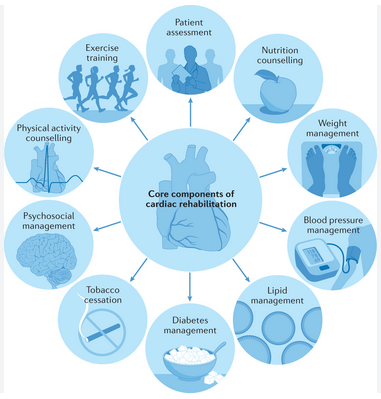Efficacy of Planned Teaching Programme on Knowledge and Practices Regarding Rehabilitation among the Clients with Selected Cardiac Conditions from Tertiary Care Hospital
Main Article Content
Abstract
Background: In order to improve quality of life, cardiac rehabilitation's ultimate goal is to let patients resume their normal daily activities while also ensuring their psychological stability. Cardiovascular disease (CVD) is the leading cause of death worldwide, with low- and middle-income countries accounting for the majority of fatalities. Cardiovascular rehabilitation is made more understandable to patients, which lowers the burden of sickness and boosts survival rates. Education about healthy habits that will keep people healthy is a duty of the nursing profession. The objective of this study assessed pre-existing knowledge & practice regarding cardiac rehabilitation, add the impact of planned teaching programs on cardiac rehabilitation among clients with selected cardiac conditions, and find out the association between knowledge and practice with demographic variables.
Material and Methods: The current study's methodology was evaluative. In that, 60 patients from Krishna Hospital Karad with specific heart problems were included. Utilizing a single group pre-test and post-test design with non-probability purposeful sampling. On the first day of the pre-test, selected cardiac patients were asked about their knowledge of exercise, diet, medication, lifestyle patterns, follow-up, and check-up procedures for cardiac patients using structured questionnaires, and information about cardiac rehabilitation was provided side by side. A post-test was then administered after seven days. Data was gathered, collated, and examined in light of the study's goal.
Result: The mean knowledge score after the test (19.28+4.26) was higher than the mean knowledge score before the test (12.66+3.20). This demonstrates the value of a carefully thought-out teaching program in raising the level of knowledge of chosen cardiac patients about exercise, food, medicine, lifestyle choices, follow-up, and checkups. Therefore, the study came to the conclusion that an organized planned teaching program was an efficient way to enhance cardiac patients' health and stop further difficulties.
Conclusion: It was successful to administer the intended planned teaching program chosen for cardiac patients regarding exercise, food, medication, lifestyle patterns, follow-up, and check-ups of cardiac patients.
Article Details
References
World Health Organization. Global Status Report of NCD 2010. Geneva. World Health Organization. 2011.
Park. J. E and Park. K. Textbook of Preventive and Social Medicine, 13th edition, Jabalpur: Bhanot Publisher, page 270, (1997).
Fuster V, Kelly BB, and Board for Global Health. Promoting cardiovascular health indeveloping world: a critical challenge to achieve global health. Institute of Medicine. Washington (DC): National Academies Press (US); 2010.
Saunder. S., Textbook of Rehabilitation 2nd edition, New Delhi: Jaypee Brother, 366-369, (2002).
Gupta R, Joshi PP, Mohan V, et al. Epidemiology and causation of coronary heart disease and stroke in India. Heart. 2008; 94:16-26.
Nayera Mohamed Tantaewy, Amany M Shebl, Wafaa Ismail Sherief et al; Effect of Cardiac Rehabilitation Program on Lifestyle Pattern of Patients with Myocardial Infraction, Journal of Biology, Agriculture and Healthcare, 2013, Vol.3, No.8.
Brandi J. Witt, MD et al, Cardiac rehabilitation after myocardial infarction in the community, J Am Coll Cardiol. 2004;44(5):988-996;
Leon, A. Cardiac Rehabilitation and Secondary Prevention of Coronary Heart Disease. An American Heart Association Scientific Statement. Circulation, 2005:111:369-76.
Shalet Alex, Ancy Ramesh et al; Efficacy of an information booklet on knowledge regarding cardiac rehabilitation among patients with coronary artery disease, International Journal of Science and research, 2012, Vol.3, 358.
American Association of Cardiovascular and Pulmonary Rehabilitation. Guidelines for Cardiac Rehabilitation and Secondary Prevention Programs. 4th edition. Champaign, Ill: Human Kinetics; 2004.
Levine SA, Lown B. The "chair" treatment of acute thrombosis. Trans Assoc Am Physicians 1951; 64:316-27.
Morris JN, Heady JA. Mortality in relation to the physical activity of work: a preliminary note on experience in middle age. Br J Ind Med 1953; 10:245-54.
Saltin B, Blomqvist G, and Mitchell JH, et al. Response to exercise after bed rest and after training. Circulation 1968; 38:VII1-78.
Bethell HJ. Cardiac rehabilitation: from Hellerstein to the millennium. Int J Clin Pract 2000; 54:92-7.
Naughton J, Lategola MT, Shanbour K. A physical rehabilitation program for cardiac patients: a progress report. Am J Med Sci 1966; 252:545-53.
Wannamethee SG, Shaper AG, Walker M. Physical activity and mortality in older men with diagnosed coronary heart disease. Circulation 2000; 102:1358-63.
Yusuf S, Hawken S, Ounpuu S, et al. Effect of potentially modifiable risk factors associated with myocardial infarction in 52 countries (the INTERHEART study): case-control study. Lancet 2004; 364:937-52.
Broustet JP, Monpère C., Cooperative survey of the results of coronary surgery during cardiac rehabilitation. Arch Mal Coeur Vaiss 1994; 87:1267-73.
Stewart KJ, Badenhop D, Brubaker PH, et al. Cardiac rehabilitation following percutaneous revascularization, heart transplant, heart valve surgery, and for chronic heart failure. Chest 2003; 123:2104-11.
Sullivan MJ, Higginbotham MB, Cobb FR. Exercise training in patients with severe left ventricular dysfunction. Hemodynamic and metabolic effects. Circulation 1988; 78:506-15.
Zwisler AD, Soja AM, Rasmussen S, et al. Hospital-based comprehensive cardiac rehabilitation versus usual care among patients with congestive heart failure, ischemic heart disease, or high risk of ischemic heart disease: 12-month results of a randomized clinical trial. Am Heart J, 2008; 155:1106-13.
Ueno A, Tomizawa Y. Cardiac rehabilitation and artificial heart devices. J Artif Organs 2009; 12:90-7.
Naughton J. Exercise training for patients with coronary artery disease. Cardiac rehabilitation revisited. Sports Med 1992;14:304-19
Squires RW, Gau GT, Miller TD, et al. Cardiovascular rehabilitation: status, 1990. Mayo Clin Proc 1990; 65:731-55.

